#Knossos
Explore tagged Tumblr posts
Text

The Toreador Fresco, Knossos Palace, Crete, c.1500 BC
#art#artistic#fresco#minoan civilization#ancient art#minoan crete#greece#ancient greece#knossos#crete
363 notes
·
View notes
Text
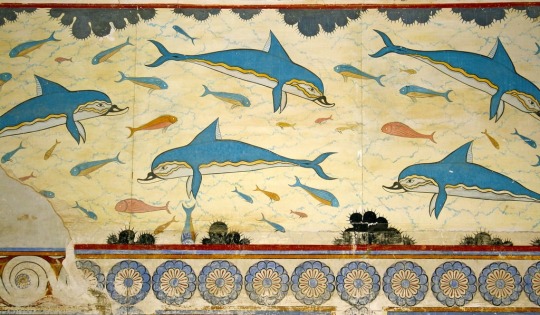
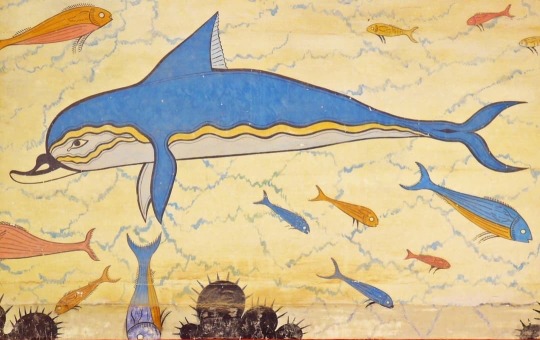
Dolphins Fresco, Palace of Knossos (& detail)
c. 1700-1450 B.C.
#knossos#fresco#dolphins#ancient art#antiquities#minoan civilization#minoan art#minoan#beautiful animals#nature#wildlife#beautiful dolphin#aesthetic#beauty#animals in art#art history#aesthetictumblr#ancient history#ancient world#tumblraesthetic#tumblrpic#tumblrpictures#tumblr art#tumblrstyle#artists on tumblr
2K notes
·
View notes
Text

A little anatomy-study, based on that one famous Bull-Leaping Fresco from Knossos.
This one has been sitting in my wips for a while, and I finally had the time to finish it.
I have been somewhat dissatisfied with my art lately, feeling that it has a certain constructed stiffness that I just can’t seem to get rid of. So I tried to challenge myself to paint something more dynamic and also not to use too many references since I noticed I tend to get too hung up on accuracy to consider the picture as a whole. I am still not fully satisfied with the result, but I hope to improve upon this in my future art.
(Close-ups)



#just for the record#I dont think my art is *bad*#I am just dissatisfied with one particular aspect of it#art#illustration#digital art#digital painting#minoan#crete#knossos#ancient greek#bronze age#taurokathapsia#bull-leaping#tagamemnon
120 notes
·
View notes
Text

"The prominence of female divinity in Minoan culture might well have reflected the prominence of Minoan women in daily life. In Shang dynasty China, the authority of goddesses such as the Eastern and Western Mothers was echoed to some degree by the authority of women in elite society and even the army. Fu Jing and Fu Hao, wives of King Wu Ding, led men into battle before being honoured in death with monumental tombs containing the victims of human sacrifice, battle axes, knives and arrowheads. In Egypt, many of the images of Hatshepsut were destroyed or defaced after her death when her name was removed from the official list of rulers by her male successors, who sought to claim direct descent from her husband. It is possible that images of powerful Minoan women were subject to similar mistreatment.
While there is no evidence that Minoan women ruled in the same manner as Hatshepsut, or joined battle like the women of Shang China, the sheer number of artworks depicting them centrally placed and on a larger scale than men has prompted some historians to speculate that Minoan society was matriarchal or matrilineal. ‘Neopalatial Crete,’ writes one scholar, ‘presents the best candidate for a matriarchy – if one ever existed.’ There is nothing to say that the position of Minoan women was in any way secondary to that of men.
Minoan women were certainly not confined to the weaving room. Sculptures show them playing lyres, flutes and zithers, sashaying in flounced chevron-patterned skirts and raising their arms in the air in ecstasy. In the ‘Grandstand Fresco’ from Knossos the women are more carefully delineated in paint than the men. Each woman has her own identity, her own style. The women appear to occupy the main rooms of the palace while the men congregate as an anonymous mass beyond. Women depicted seated – a sign of divinity or authority – are often being approached by men or animals. A highly enigmatic fresco at Thera (Santorini), for example, features a woman wearing large hoop earrings, a snake in her hair, and a neck-chain of ducks, sitting on a dais with a griffin beside her while a blue monkey pays her court.
On a gold ring, a female deity, we may presume, is seated beneath a tree, where she receives flowers from two women. A smaller figure of a man with a double-headed axe over his head hovers between them. By depicting the man beneath the axe, and on a smaller scale than the women, the engraver of the ring perhaps hoped to convey that he was a divine vision, almost a thought-bubble, originating in one of the female worshipper’s heads. Trees, as Arthur Evans recognised, were sacred in Minoan culture, and were perhaps believed to be capable of inspiring divine visions in those who honoured them. Such artworks contribute to the picture of Minoan women exerting considerable religious authority in the palace complexes and society more widely.
Minoan women also played a crucial role in ritual. The early Minoans sometimes interred their dead twice by exhuming the bones of their family members and resettling them later in jars. The more usual custom, however, was to bury the dead in chamber tombs or stone beehive-shaped ‘tholos’ tombs, clay sarcophagi or, in the case of infants, under the floorboards of the home. The colourful paintings on a rare limestone sarcophagus from Hagia Triada, circa 1400 bc, show three men carrying young animals and a model boat to the deceased, who stands in front of his tomb, ready to receive his provisions for the afterlife. There are also three women present, the first of whom pours a libation into a cauldron placed between two upright axes mounted by birds; the second carries further vessels; the third – darker skinned like the men and thus possibly of lower social status – has a lyre. On the other side of the sarcophagus the women assist in the sacrifice of a bull on an altar. Other wall paintings show women involved in rituals of their own involving blood. A fresco from Akrotiri features a group of women, one of whom sits beside a sunken room or ‘lustral basin’ with a bleeding foot. A tree also bleeds. It is possible that lustral basins were used for purification by women during or after menstruation."
The Missing Thread: A Women's History of the Ancient World, Daisy Dunn
#history#women in history#women's history#historyedit#minoan women#minoan civilization#bronze age#crete#knossos#ancient history#ancient world#powerful women#historical figures
155 notes
·
View notes
Text
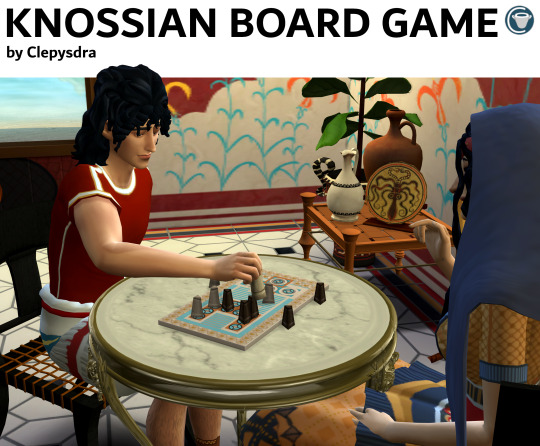

Knossian Board Game
This is modeled after an ancient bronze age artefact unearthed at Knossos, believed by archeologists to be an early board game.
The game is a chess clone and playing it will increase the logic skill.
Make sure when you are placing the object in build mode, you first attach chairs to the board game itself, and then place a table of your choosing underneath the game (using the commands testingcheats true and then bb.moveobjects on). If you do not follow these steps, the sims will not be able to sit and play!
BOARD GAME DOWNLOAD - Dropbox (no ads)
#my cc#my bb cc#sims 4 cc#sims 4 mods#sims 4 buy cc#sims 4 buy mode#sims 4 build and buy#minoan#knossos#bronze age#ts4cc#ts4mm#ts4 history#ts4 early history#ts4 ancient history#ts4 historical#ts4 historical cc#s4cc#ts4 cc
405 notes
·
View notes
Photo

This map illustrates the geopolitical evolution in the Aegean during the Bronze Age when the dominant civilizations of the region - the Minoans and Mycenaeans- played distinct roles. The Minoans (2000–1450 BCE) on Crete were renowned for their maritime trade, elaborate palaces like Knossos, and sophisticated art, while the Mycenaeans (1600–1100 BCE) were more militaristic, building fortified citadels...
54 notes
·
View notes
Text
Do you think the Minotaur ever lamented his loneliness in the Labyrinth of Knossos. Do you think he made some small corner of it a home. Do you think he traced the cracks in its walls with knowing fingers. Do you think he found happiness despite it all?
160 notes
·
View notes
Text

Knossos, Crete
#art#greece#byzantium#ancient greece#history#hellas#ancient history#archaeology#minoans#knossos#crete
14 notes
·
View notes
Text
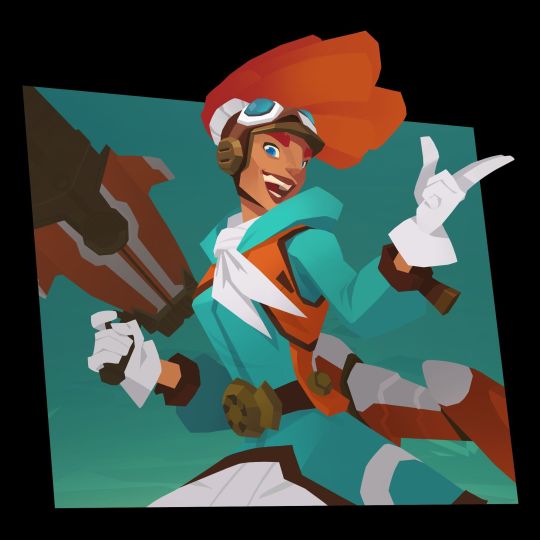



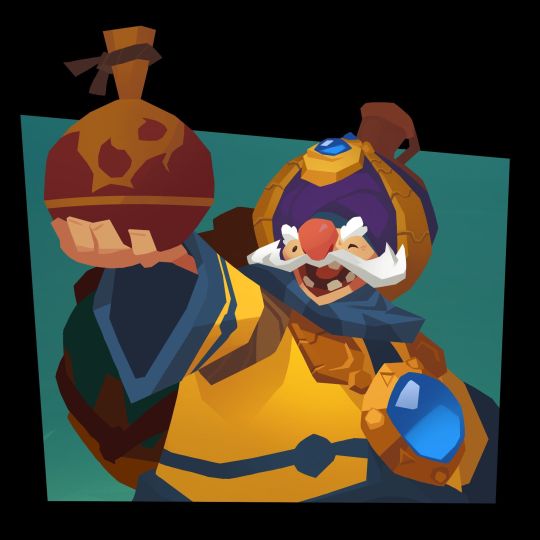
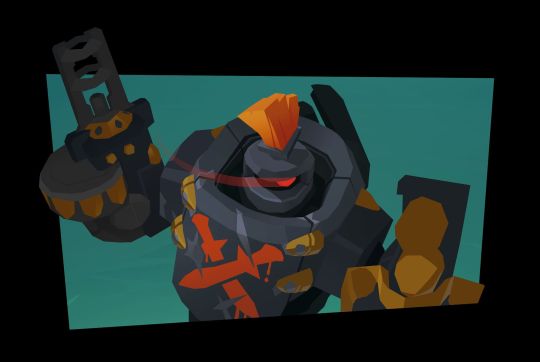
Character Art by Eric Dagley
#gigantic#go gigantic#gogigantic#gigantic game#ggntc#beckett#knossos#pakko#charnok#uncle sven#hk-206#pleasantly surprised!! i havent seen some of these
76 notes
·
View notes
Text
The Top 6 Penis Bones in Archaeology

Video on YouTube here: https://youtu.be/h3I9ny2O8XI
It's got dickbones, non-dickbones, cool archaeology, paleontology, and biology, some more wangs, and a few jokes. Check it out and share it with friends!
#archaeology#scicomm#baculum#bacula#dick bones#bony wangs#prehistory#history#domestication of dogs#bone tools#zooarchaeology#paleontology#La Brea Tar Pits#Knossos#Anderson Site#Amsterdam#bone jokes
67 notes
·
View notes
Photo
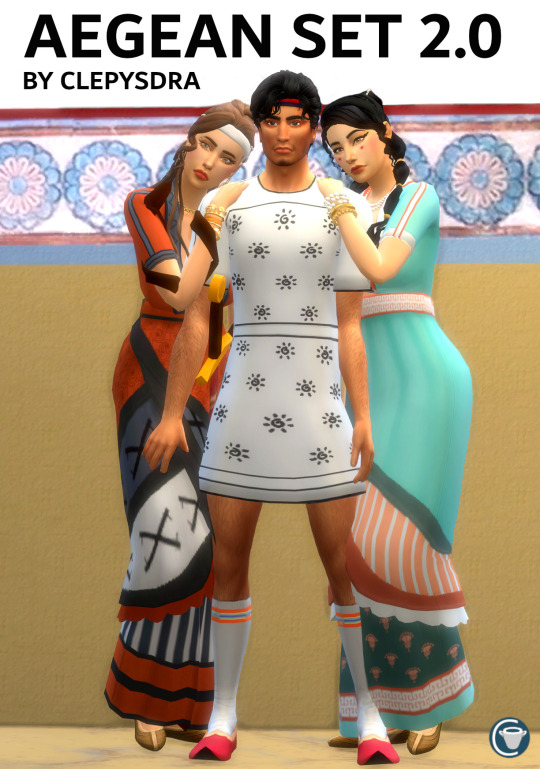

Aegean Set 2.0
Revisiting Ariadne and Phaedra to give them some clothes! And also a tunic for Theseus. The outfits are based off of ancient Minoan and Mycenaean clothing (with huge inspiration taken from the reconstructions by Dr. Bernice Jones; I don’t think I’d be able to visualize their shapes from the ancient frescos alone), although some swatches are more historically accurate than others.
~You can find the first half of the Aegean set here.~
Ariadne Dress (UPDATED 1/2/24)
Long dress category
15 swatches
Base game compatible
Feminine
Theseus Tunic
Short dress category
17 swatches
Base game compatible
Masculine
DRESS DOWNLOAD - Dropbox (no ads)
TUNIC DOWNLOAD - Dropbox (no ads)
~Also, the Manthos sword on Theseus’ hip is by the amazing @kyriat-sims~
#my cc#s4cc#ts4cc#minoan#mycenaean#mycenae#knossos#aegean#mediterranean#bronze age#ts4 history#ts4mm#ariadne#phaedra#theseus#mythology#history#ancient history#crete#cretan#greek#ancient greece#greece#mythos
442 notes
·
View notes
Text
So my wife and I had our honeymoon on Crete recently and in the museum of Heraklion we saw her:
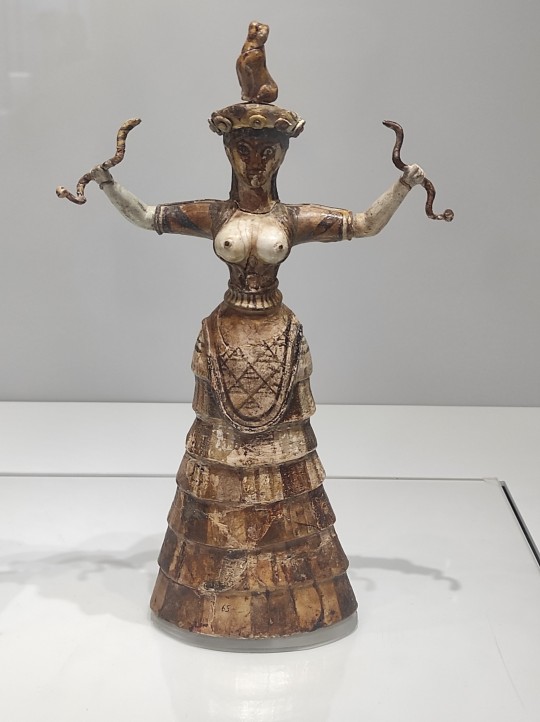
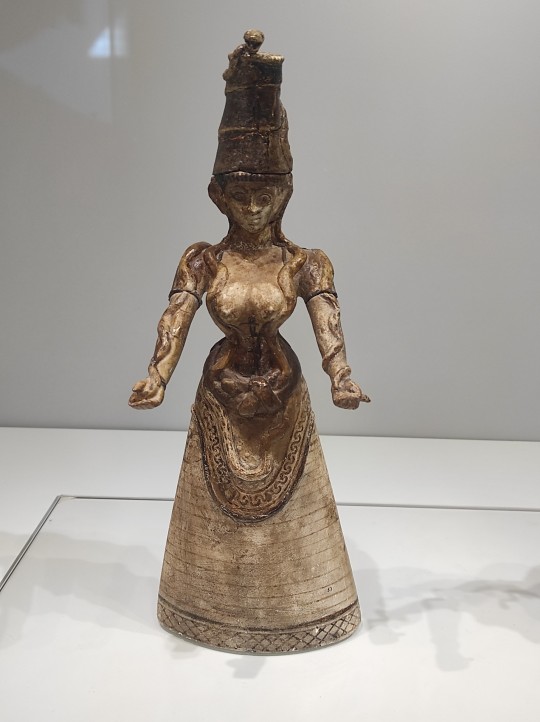

I am obsessed!
What do you mean there was a possible Goddess of nature AND cats AND snakes and no one told me about this before??
So basically the Minoan civilization was one of the first civilisations in Europe and we know very little about them and what we know of them comes largely from the fact they were really talented artists, to the point where they have been hired by the Egyptian Pharos. They had a lot of cults on the Greek island Crete and built big labyrinth like "Palaces" there, which we by now know, probably weren't palaces at all. Most often they are assumed to have been temples, but it is subject of ongoing debate. Unrelated to the snake goddess (probably?) they found a cave on Crete filled with double edged axe heads of varying sizes, probably for religious reasons(?) because some of these sizes don't make sense as weapons or tools.
Why did Greek mythology tumblr not tell me about this?
Anyway I bought myself a tiny figure and a T-Shirt (picture below) of the snake goddess and am planning to become a collector of her merchandise now.
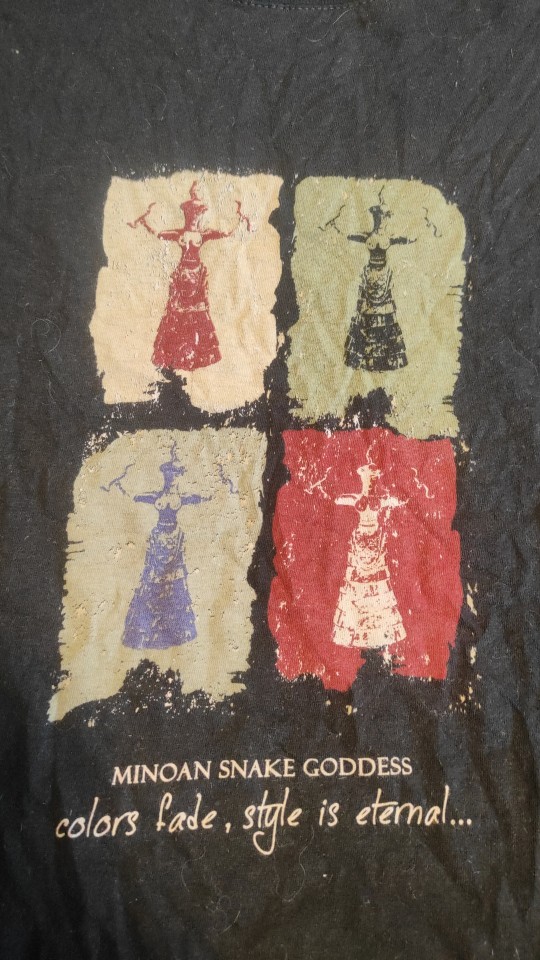
Anyway, I have been reading up on the Minoan culture on wiki and I advise other history or mythology nerds to do the same.
#minoan#minoan snake goddess#mythology#greek mythology#crete#crete mythology#minoan mythology#snake goddess#nature goddess#cat goddess#greek islands#goddess#snakes#knossos#heraklion#greek#greece#classical antiquity#classical era#history#european#european history#greek history#anthropology#history nerd#mythology nerd#colors fade#style is eternal
34 notes
·
View notes
Text

Place of minos at knossos (1921)
26 notes
·
View notes
Text

''Ladies in Blue'' Palace of Knossos in Crete. Ca. 1525–1450 BC. Archaeological Museum of Herakleion. PS. This is not my photo. I found it and it should be shared in my opinion.
15 notes
·
View notes
Text


#illustration#drawing#art#illustrated#sketchbook#artists on tumblr#minoan#minoan crete#gouache painting#gouache#knossos#ancient greek#archeological illustration
7 notes
·
View notes
Text
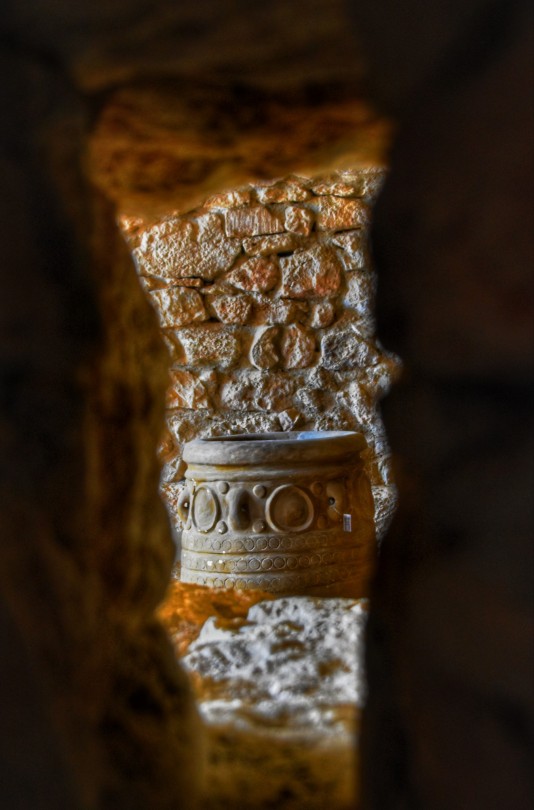
We always see not enough in life and in history.
December 2024
Knossos Palace in Heraklion
#photographers on tumblr#photography#original photographers#photo#heraklion#museums#archeology#knossos
12 notes
·
View notes